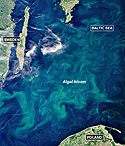A satellite image from the European Space Agency shows a vast algal bloom that could pose a risk to marine life in the Baltic Sea. The 377,000-square-kilometer (145,000-square-mile) blue-green bloom, which stretches from Finland to parts of Germany and Poland, is the largest scientists have seen in the Baltic in five years. They believe a prolonged stretch of warm sea temperatures and a lack of wind, coupled with fertilizer from regional agriculture washing into the Baltic, have caused the bloom. Similar blooms have spread over the Baltic each summer for decades as excess nutrients trigger a rapid growth of phytoplankton and algae. This rapid growth consumes oxygen in the water, threatening marine life and destabilizing ecosystems across the region. The arrival of strong winds and waves, along with cooler ocean temperatures, could break up the bloom.
Massive Baltic Algal Bloom Is Captured in European Satellite Image
More From E360
-
Solutions
From Ruins to Reuse: How Ukrainians Are Repurposing War Waste
-
ANALYSIS
Carbon Offsets Are Failing. Can a New Plan Save the Rainforests?
-
Energy
Facing a Hostile Administration, U.S. Offshore Wind Is in Retreat
-
Biodiversity
As Jaguars Recover, Will the Border Wall Block Their U.S. Return?
-
WATER
An E.U. Plan to Slash Micropollutants in Wastewater Is Under Attack
-
INTERVIEW
This Data Scientist Sees Progress in the Climate Change Fight
-
Climate
As Floods Worsen, Pakistan Is the Epicenter of Climate Change
-
Climate
Heat Stress Is a Major Driver of India’s Kidney Disease Epidemic
-
Energy
It’s a ‘Golden Age’ for U.S. LNG Industry, But Climate Risks Loom
-
Climate
How Climate Risks Are Putting Home Insurance Out of Reach
-
INTERVIEW
Inside the Plastics Industry Playbook: Delay, Deny, and Distract
-
Biodiversity
Freeing Captive Bears from Armenia’s Backyards and Basements
